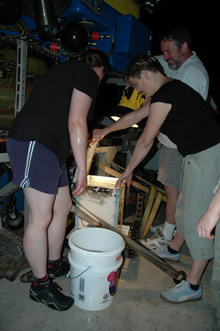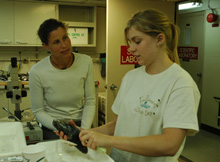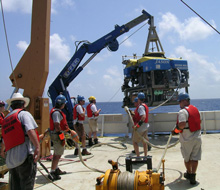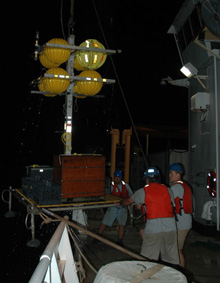During the day, the main lab is a busy scene with scientists discussing upcoming dive plans, processing samples, and preparing instruments for the next dive. Click image for larger view and image credit.
In the bio lab, Erin Becker and Irmi Eichinger are processing the remainder of the mussel samples. Processing involves opening the mussel and removing a small portion of the mantle and gill. The samples are then put into vials and placed on ice. Click image for larger view and image credit.
After Midnight
July 4, 2007
Nicole M. B. Morris
NOAA Office of Ocean Exploration
26º 10.82 N
94º 37.39 W
After midnight, we’re gonna let it all hang down . . .
This is just what folks on the midnight shift think every morning before they enter the Jason control van. Some of the five or six watch members are wide awake, just up from some much needed sleep, while the others are finishing their day off with the remotely operated vehicle (ROV) watch. As for me, I am the latter, finishing my day at 4 am. As is for most people, going to sleep at 4 am is not my normal routine. I am much more of a morning person than a night owl. But instead of being roused by my usual 6 am alarm, I am now waking up at noon.
During daylight hours, the Jason ROV control van is full of scientists who oversee the science operations taking place on the sea floor. The scene is very similar in the labs, where scientists are processing water and sediment samples; measuring tubeworms, mussels, and other seep fauna; analyzing different types of data; preparing for the next dive; and getting other tasks in order. But after midnight (on most days), things are much calmer. The scene at that time is rather different in both the control van and science labs. Many people are either finishing up the day’s tasks, taking advantage of the downtime by watching a movie, reading a book, playing some ping pong, or sleeping off the day.
The Jason group, with the help of the Ronald H. Brown deck crew, lowers the Jason remotely operated vehicle (ROV) into the water. Click image for larger view and image credit.
James Brennan, Brian Bingham, and Casey Agee recover the elevator onto the deck. Samples, including push cores and mussels, will be removed and processed as soon as the elevator is secured. Click image for larger view and image credit.

Upon ROV recovery to the surface, Jason pilot Bob Waters helps Stephanie Lessard-Pilon and Julia Zekely quickly collect samples from a well-lit biobox. Click image for larger view and image credit.
This is quite the opposite for the midnight crew. We are sitting in the Jason control van and performing our various tasks. These range from piloting and navigating the ROV to monitoring the ROV systems, logging the biological and geological observations, and changing and labeling DVDs. It is rather quiet during these wee morning hours, with only a few people wandering in and out of the control van.
So, if you like the quiet, the midnight watch is for you . . .
Then, just like that, the quiet morning hours can turn into the great hustle and bustle of the day. Jason/Medea and elevator recoveries can instantly replace serenity with the liveliness of the day. The science party becomes busy again, gathering samples from the Jason basket or elevator, and rushing them into the labs to be processed and analyzed. The midnight shift is ever changing from a quiet atmosphere to a busy one resembling the daylight hours.
You may be asking yourself: do you ever really get used to any schedule while out on the ship? I would answer that I am getting used to my noon to 4 am schedule. I am slowly changing from the morning person I was before this cruise. So maybe when I get back to Washington D.C., I can still show up to work around noon every day . . . What do you think, boss?



































